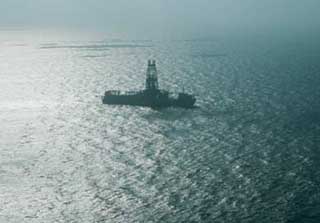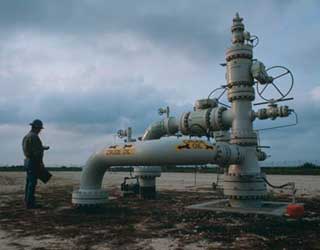 |
Oil Underwater
Photograph by Sarah Leen
One
hundred twenty miles (200 kilometers) off the Louisiana
coast, the drill ship Discoverer Enterprise prepares
for production to begin at BP's Thunder Horse oil
field in 2005. As six giant thrusters hold the ship
in place, its crew punches wells into the seabed
7,000 feet (2,000 meters) below. With an estimated
one billion barrels of crude, this field could represent
the biggest discovery yet in the Gulf of Mexico.
Developments in offshore drilling have allowed oil
companies to work in deeper and deeper waters. The
new world record—at 10,011 feet (3,050 meters)—was
set in the Gulf in November 2003.
|
It's inevitable. But just how soon will
the vital fuel become so scarce and expensive that we're
forced to make hard choices about how we live.
Below more than a mile of ocean and three
more of mud and rock, the prize is waiting. At the surface
a massive drilling vessel called the Discoverer Enterprise
strains to reach it. It's the spring of 2003, and for
more than two months now the Enterprise has been holding
steady over a spot 120 miles (200 kilometers) southeast
of New Orleans in the Gulf of Mexico. The ship is driving
a well toward an estimated one billion barrels of oil
below the seafloor—the biggest oil field discovered
in United States territory in three decades.
The 835-foot (255-meter) Enterprise shudders
every few minutes as its thrusters put out a burst of
power to fight the strong current. The PA system crackles,
warning of small amounts of gas bubbling from the deep
Earth. And in the shadow of the 23-story-tall derrick,
engineers and managers gather in worried knots. "We've
got an unstable hole," laments Bill Kirton, who's
overseeing the project for the oil giant BP.
The drill, suspended from the Enterprise's derrick through
a swimming-pool-size gap in the hull, has penetrated 17,000
feet (5,000 meters) below the seafloor. Instead of boring
straight down, it has swerved more than a mile sideways,
around a massive plume of rock salt. But now, with 2,000
feet (600 meters) to go, progress is stalled. Water has
begun seeping into the well from the surrounding rock,
and the engineers are determined to stem its spread before
drilling farther. Otherwise, the trickle of water could
turn into an uncontrolled surge of crude. "There's
a lot of oil down there wanting to come out," says
Cecil Cheshier, a drilling supervisor, after struggling
all night with the unruly hole. "You can cut corners
and take chances—but that could cost you a lawsuit
or cause a spill into the Gulf of Mexico, and then deepwater
drilling gets shut down."
The troubled well is just one of 25 that
BP plans to drill in the giant field, called Thunder Horse,
which sprawls over 54 square miles (140 square kilometers)
of seafloor. The entire project, including a floating
platform half again as wide as a football field that will
collect the oil from individual wells and pipe it to shore
starting next year, will cost four billion dollars. But
if the wells live up to expectations, each will eventually
gush tens of thousands of barrels a day. "That's
like a well in Saudi Arabia," says Cheshier. "We
hardly get those in the U.S. anymore."
You wouldn't know it from the hulking SUVs and traffic-clogged
freeways of the United States, but we're in the twilight
of plentiful oil. There's no global shortage yet; far
from it. The world can still produce so much crude that
the current price of about $30 for a 42-gallon barrel
would plummet if the Organization of the Petroleum Exporting
Countries (OPEC) did not limit production. This abundance
of oil means, for now, that oil is cheap. In the United
States, where gasoline taxes average 43 cents a gallon
(instead of dollars, as in Europe and Japan), a gallon
of gasoline can be cheaper than a bottle of water—making
it too cheap for most people to bother conserving. While
oil demand is up everywhere, the U.S. remains the king
of consumers, slurping up a quarter of the world's oil—about
three gallons a person every day—even though it has
just 5 percent of the population.
 |
What Lies Beneath
Photograph by Sarah Leen
The
wellhead is just the tip of the iceberg at an oil
storage cavern in Bryan Mound, Texas, where an employee
of the Strategic Petroleum Reserve (SPR) does routine
monitoring. Beneath the wellhead is an underground
salt cavern the size of the Empire State Building.
The SPR, the largest such reserve in the world,
began operations in 1977 as an emergency crude oil
storage site, ready to be drawn on should a disruption
in commercial oil supplies pose a threat to the
U.S. economy. Located at four sites in Texas and
Louisiana, the reserve can hold up to 700 million
barrels of crude oil. Should the need arise, a maximum
of 4.3 million barrels of oil a day can be tapped
from the reserve for 90 days. And delivery is swift.
Once the President gives the go-ahead, oil can be
on the U.S. market in 13 days.
|
Yet as the Enterprise drillers know, slaking
the world's oil thirst is harder than it used to be. The
old sources can't be counted on anymore. On land the lower
48 states of the U.S. are tapped out, producing less than
half the oil they did at their peak in 1970. Production
from the North Slope of Alaska and the North Sea of Europe,
burgeoning oil regions 20 years ago, is in decline. Unrest
in Venezuela and Nigeria threatens the flow of oil. The
Middle East remains the mother lode of crude, but war
and instability underscore the perils of depending on
that region.
And so oil companies are searching for new supplies and
braving high costs, both human and economic. Making gambles
like Thunder Horse and venturing into West Africa and
Russia, they are still finding oil in quantities to gladden
a Hummer owner's heart. But in the end the quest for more
cheap oil will prove a losing game: Not just because oil
consumption imposes severe costs on the environment, health,
and taxpayers, but also because the world's oil addiction
is hastening a day of reckoning.
Humanity's way of life is on a collision course with geology—with
the stark fact that the Earth holds a finite supply of
oil. The flood of crude from fields around the world will
ultimately top out, then dwindle. It could be 5 years
from now or 30: No one knows for sure, and geologists
and economists are embroiled in debate about just when
the "oil peak" will be upon us. But few doubt
that it is coming. "In our lifetime," says economist
Robert K. Kaufmann of Boston University, who is 46, "we
will have to deal with a peak in the supply of cheap oil."
Full story is available from National
Georgraphic, June 2004 Issue
|